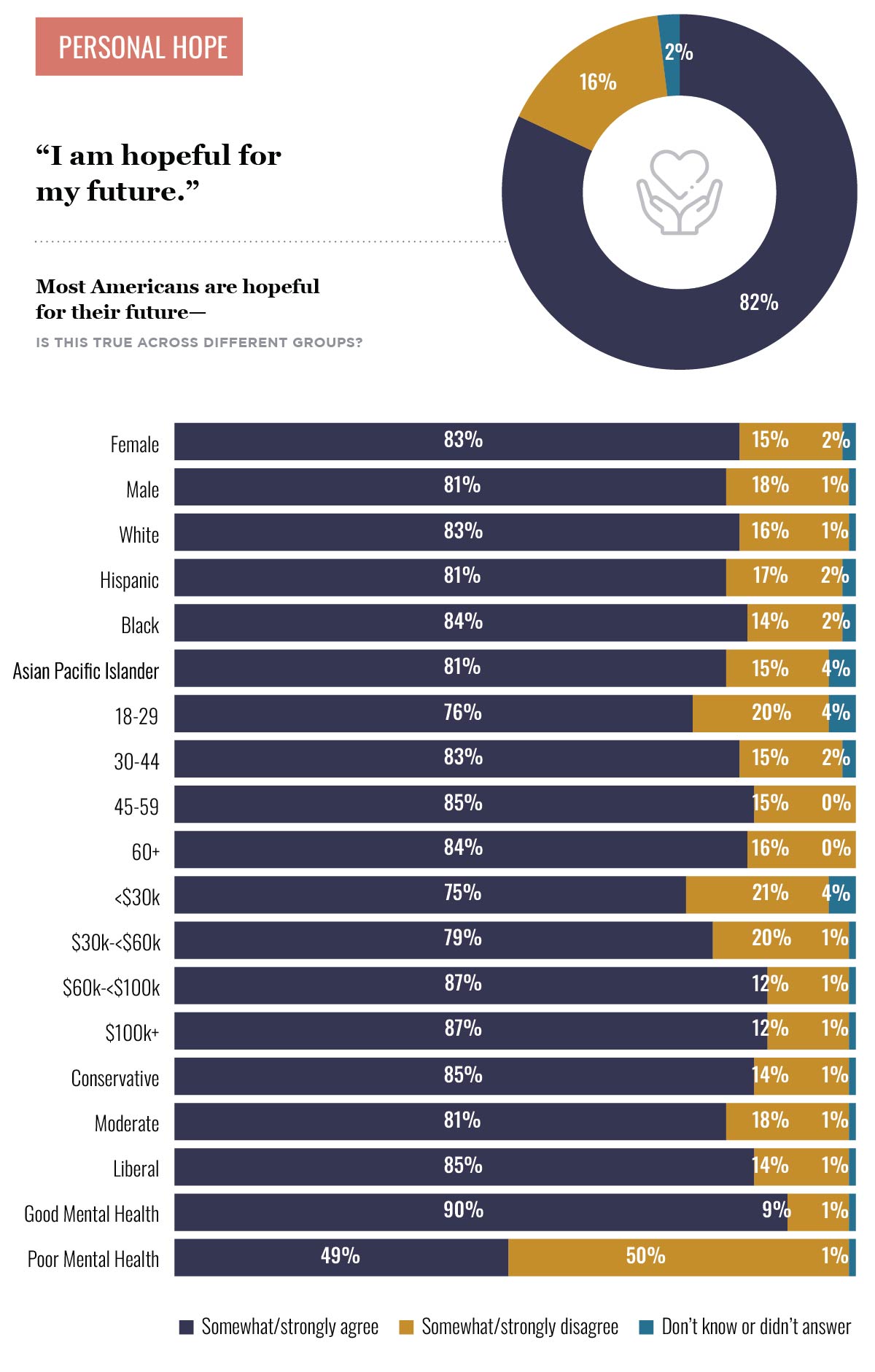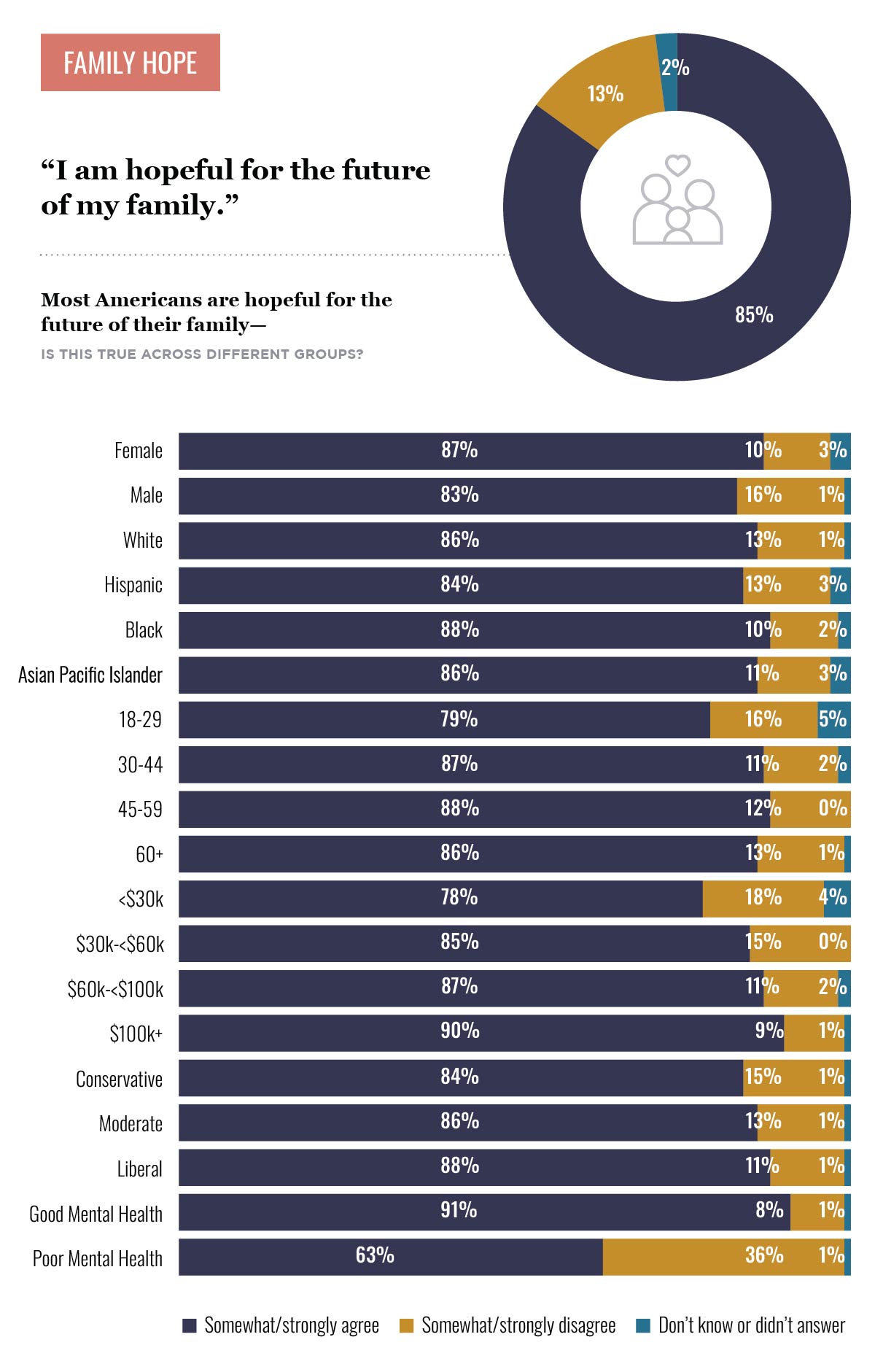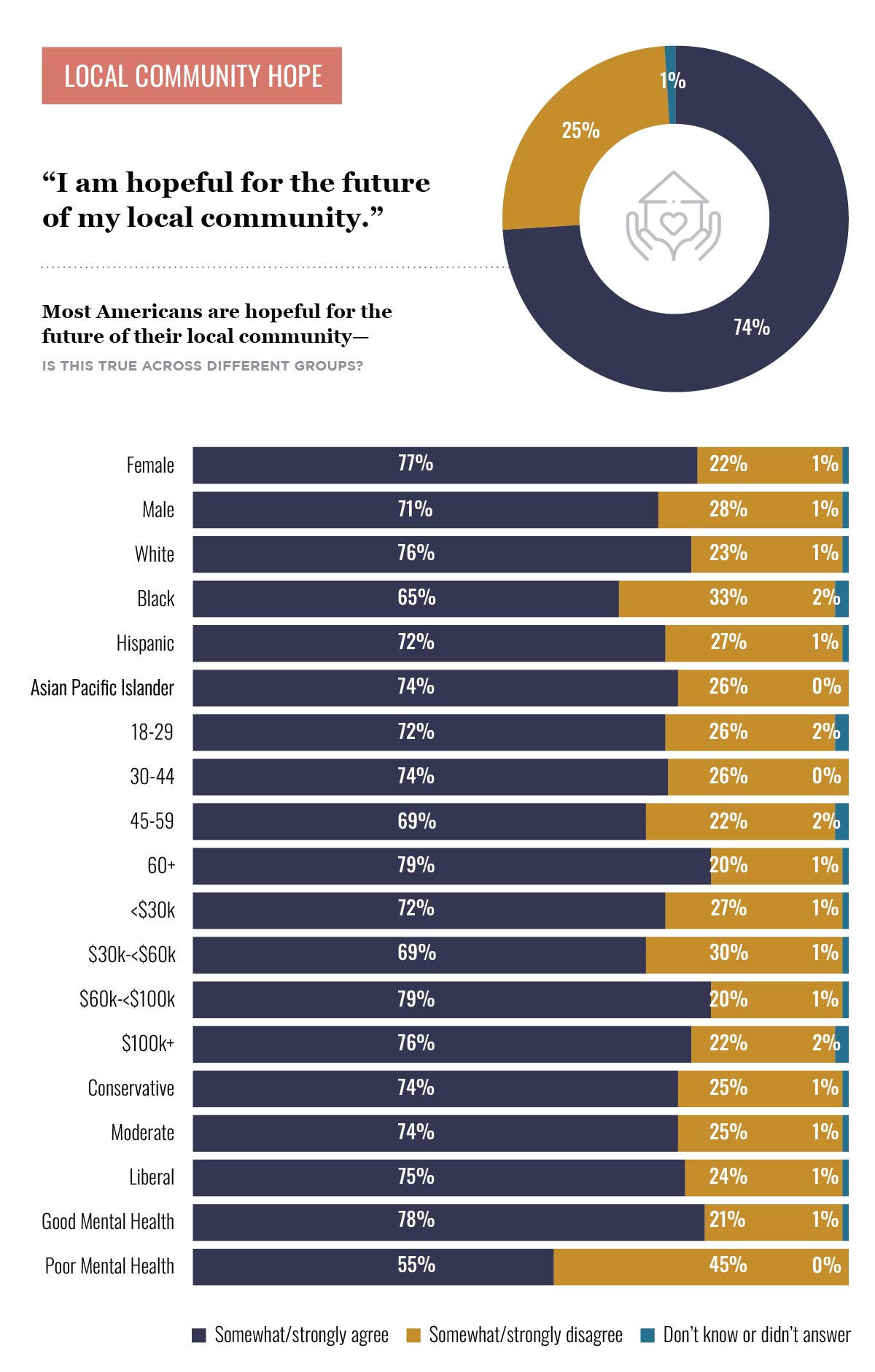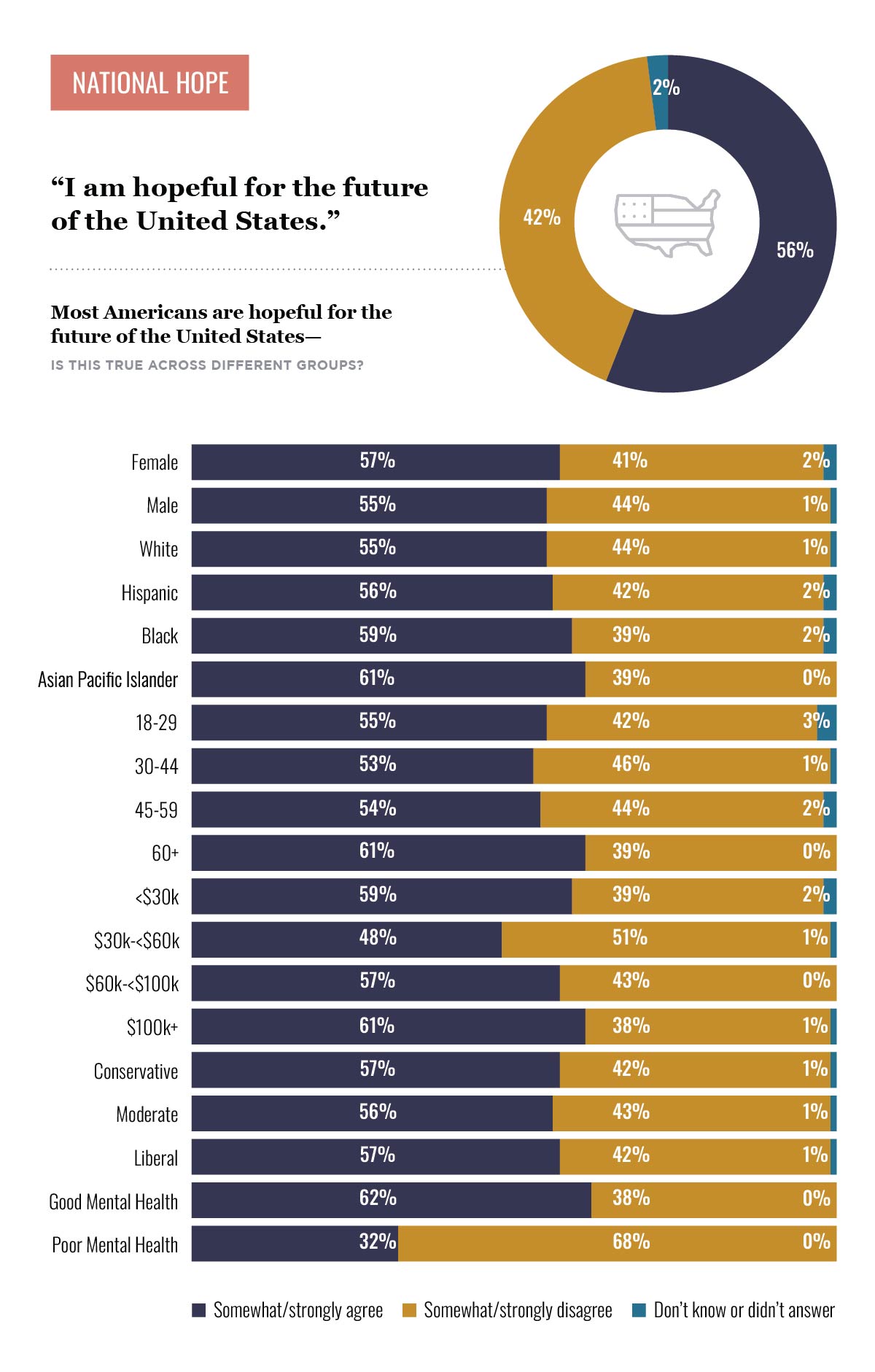Hope is a critical component of individual and societal flourishing, and it plays an important role in advancing human progress. When people are hopeful, they are more driven, resilient, open-minded, creative, innovative, and effective at solving problems. The United States has a reputation for being a hopeful nation, but surveys also suggest that Americans are feeling increasingly disheartened about the future. Our team at the Human Flourishing Lab conducted a survey to better understand the current state of hope in the United States. We asked a nationally representative sample of just over 2,000 American adults to report their agreement with statements regarding hopefulness for their own future, the future of their family, the future of their local community, and the future of their country. We also presented survey respondents with a positive and negative vision of the future of human progress and asked them which vision they agreed with most.
KEY INSIGHTS
- Most Americans are hopeful for their own future (82%), the future of their family (85%), and the future of their local community (74%).
- Only a slight majority of Americans (56%) are hopeful for the future of the United States.
- A minority of Americans (44%) are hopeful that humans will make significant progress on big societal and global challenges and life will be better for future generations.
- Though there are some differences on hope across demographic groups, three-quarters or more of Americans in every gender, age, household income, and racial/ethnic group are hopeful for their own future and for the future of their family.
- Across most demographic groups, nearly 70% or more of Americans are hopeful for the future of their local community. Black Americans are the exception with 65% indicating that they are hopeful for the future of their local community.
- The differences between conservatives and liberals on hope are generally small except when it comes to hope for human progress; 51% of liberals believe that humans will make significant progress on major societal and global challenges and that life will be better for future generations, compared to 37% of conservatives.
- The largest differences across every indicator of hope are between those who perceive their mental health as good and those who do not. Americans who perceive their mental health as good are far more hopeful than Americans who perceive their mental health as poor.
INTRODUCTION
Hope is more than wishful thinking. It is a self-assured and action-oriented mental state. When people are hopeful, they are not just optimistic about the future; they have a firm confidence in themselves and an unwavering belief that they will attain positive change in their lives, which allows them to persist through adversity. They are flexible in coming up with effective pathways for attaining their goals and can quickly alter their approach when they encounter obstacles or setbacks. Finally, they understand the purpose and significance of their actions and in turn lead lives full of meaning. As a result, hope supports individual success in a wide range of life domains such as education, career, and athletics. Hope is also a powerful resource for overcoming challenges faced by vulnerable populations such as individuals experiencing homelessness and refugees.
The benefits of a hopeful mindset extend beyond personal achievement. Hope is infectious. Hopeful people can inspire others to adopt a hopeful way of thinking about and approaching their lives. Hopeful people are also driven to make positive contributions to their families, communities, and the broader society. For example, hope increases community engagement and the motivation to help address large societal and global challenges. Hope is also positively associated with tolerance for others (a key component of pluralism), creativity, and innovative problem-solving. Thus, hope—particularly a hope that extends beyond one’s personal aspirations—has the potential to play an important role in advancing societal flourishing and human progress. A Human Flourishing Lab/Strengthen ND comprehensive review of the science of hope can be found here.
We conducted the current survey to better understand the state of hope in the United States. Are Americans hopeful about their own future and the future of their family? What about their local community and the nation more broadly? Do Americans believe that humans will make significant progress on big challenges so that life can be better for future generations?
To measure the current state of hope in the United States, we surveyed a nationally representative sample of just over 2,000 American adults. Survey participants were asked to report their agreement with statements regarding hopefulness for their own future, the future of their family, the future of their local community, and the future of their country. We also presented participants with a positive and negative vision of the future of human progress and asked them which vision they agreed with most.





CONCLUSION
Are Americans a hopeful people? It depends. When it comes to their own lives, their families, and their local communities, most Americans are hopeful for the future. This is true regardless of gender, age, income, race/ethnicity, or politics. Critically, hope declines across all groups when expanded beyond the local community to the national and global level. Just a slight majority of Americans report being hopeful for the future of the United States, and a minority of Americans have a hopeful vision of human progress. Liberal Americans are the only group in which at least a majority (51%) have a hopeful vision of human progress.
Hope is a positive mental state. Therefore, it is not surprising that we observed a strong relationship between mental health and hope. Most Americans (82% in the current survey) consider their mental health to be good. However, with rising rates of mental health problems, particularly among younger generations, mental health may increasingly become a major barrier to societal flourishing and human progress. Indeed, in the current survey, only 64% of Americans between the ages of 18 and 29 reported their mental health as being good, compared to 76% of those between the ages of 30 and 44, 89% of those between the ages of 45 and 59, and 91% of those 60 and older.
It is important to note that the current survey was not designed to examine a causal relationship between mental health and hope. However, given that conditions such as depression and anxiety involve negative cognitions strongly tied to hope, it is reasonable to believe that these conditions play a powerful role in undermining a hopeful mindset. It is also worth noting that the relationship between mental health and hope is likely bidirectional. For instance, hope is a protective factor when people are facing life experiences such as loneliness and trauma which are risk factors for the development of mental health conditions.
Mental health likely plays an important role in shaping people’s attitudes about their nation and human progress. However, even among Americans who report good mental health, only 62% are hopeful for the future of the United States, and only 48% have a positive vision of human progress. There must then be other psychological, social, cultural, or situational factors that deter mentally healthy people from extending their hope for the future to the nation and humanity. For example, suppose people perceive that there are significant barriers to progress such as increasing political polarization, or that they are regularly exposed to overwhelmingly negative news. In that case, they may have difficulty imagining pathways for change and progress. Given these significant sociocultural obstacles, people may also feel powerless and unsure of their ability to bring about the change they want for the world beyond their local community.
Research indicates that hopeful visions from leaders who are viewed as credible and trustworthy can inspire feelings of hope among constituents. Thus, it may be necessary to determine the extent to which trust in national and global leaders, as well as major institutions, explains this lack of hope for the future of the United States and human progress.
METHODOLOGY
For this survey, we partnered with NORC at the University of Chicago and its AmeriSpeak® panel. AmeriSpeak® is a probability-based panel designed to represent the US household population. Randomly selected US households are sampled using area probability and address-based sampling, with a known, nonzero probability of selection from the NORC National Sample Frame. The nationally representative sample consisted of 2,049 respondents. The survey was conducted from October 5-9, 2023.

A project of the Archbridge Institute
The Archbridge Institute is a non-partisan, independent, 501(c)(3) public policy think tank. Our mission is to lift barriers to human flourishing.
Sign Up For Our Newsletter
Contact
Archbridge Institute
1633 Connecticut Ave. NW, Suite 300,
Washington, DC 20009

